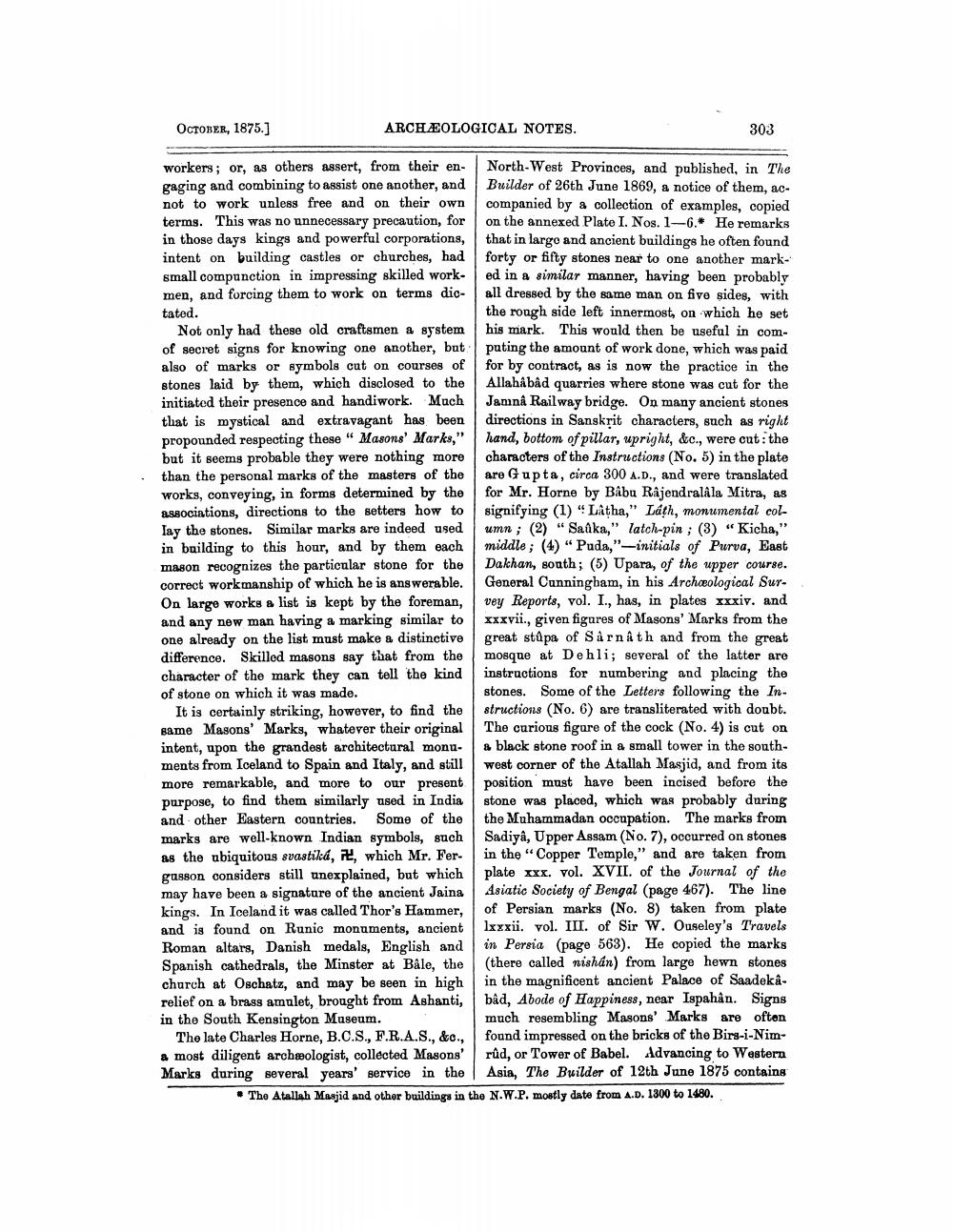________________
OCTOBER, 1875.]
ARCHÆOLOGICAL NOTES.
303
workers; or, as others assert, from their en- North-West Provinces, and published, in The gaging and combining to assist one another, and Builder of 26th June 1869, a notice of them, acnot to work unless free and on their own companied by a collection of examples, copied terms. This was no unnecessary precaution, for on the annexed Plate I. Nos. 1-6.. He remarks in those days kings and powerful corporations, that in large and ancient buildings he often found intent on building castles or churches, had forty or fifty stones near to one another marksmall compunction in impressing skilled work ed in a similar manner, having been probably men, and forcing them to work on terms dic- all dressed by the same man on five sides, with tated.
the rough side left innermost, on which he set Not only had these old craftsmen a system his mark. This would then be useful in comof secret signs for knowing one another, but pating the amount of work done, which was paid also of marks or symbols cut on courses of for by contract, as is now the practice in the stones laid by them, which disclosed to the Allahabad quarries where stone was cut for the initiated their presence and handiwork. Much Jamna Railway bridge. On many ancient stones that is mystical and extravagant has been directions in Sanskrit characters, such as right propounded respecting these " Masons' Marks," hand, bottom of pillar, upright, &c., were cut: the but it seems probable they were nothing more characters of the Instructions (No. 5) in the plate than the personal marks of the masters of the are Gupta, circa 300 A.D., and were translated works, conveying, in forms determined by the for Mr. Horne by Babu Rajendralâla Mitra, as associations, directions to the setters how to signifying (1) "Latha," Láth, monumental collay the stones. Similar marks are indeed used umn ; (2) “Sallka," latch-pin ; (3) “Kicha," in building to this hour, and by them each middle ; (4) "Puda,"-initials of Purva, East mason recognizes the particular stone for the Dakhan, south; (5) Upara, of the upper course. correct workmanship of which he is answerable. General Cunningham, in his Archæological Sur. On large works a list is kept by the foreman, vey Reports, vol. I., has, in plates xxxiv. and and any new man having a marking similar to xxxvii., given figures of Masons' Marks from the one already on the list must make a distinctive great stapa of Sarnath and from the great difference. Skilled masons say that from the mosque at Dehli; several of the latter are character of the mark they can tell the kind instructions for numbering and placing the of stone on which it was made.
stones. Some of the Letters following the InIt is certainly striking, however, to find the structions (No. 6) are transliterated with doubt. same Masons' Marks, whatever their original The curious figure of the cock (No. 4) is cut on intent, upon the grandest architectural monu- | black stone roof in a small tower in the southments from Iceland to Spain and Italy, and still west corner of the Atallah Masjid, and from its more remarkable, and more to our present position must have been incised before the purpose, to find them similarly used in India stone was placed, which was probably during and other Eastern countries. Some of the the Muhammadan occupation. The marks from marks are well-known Indian symbols, such Sadiya, Upper Assam (No. 7), occurred on stones as the ubiquitous svastika, 7, which Mr. Fer- in the “Copper Temple," and are taken from gusson considers still unexplained, but which plate xxx, vol. XVII. of the Journal of the may have been a signature of the ancient Jaina Asiatic Society of Bengal (page 467). The line kings. In Iceland it was called Thor's Hammer, of Persian marks (No. 8) taken from plate and is found on Runic monuments, ancient Ixxxi. vol. III. of Sir W. Ouseley's Travels Roman altars, Danish medals, English and in Persia (page 563). He copied the marks Spanish cathedrals, the Minster at Bâle, the (there called nishan) from large hewn stones church at Oschatz, and may be seen in high in the magnificent ancient Palace of Saadekarelief on a brass amulet, brought from Ashanti, bâd, Abode of Happiness, near Ispahân. Signs in the South Kensington Museum.
much resembling Masons' Marks are often The late Charles Horne, B.C.S., F.R.A.S., &c., found impressed on the bricks of the Birs-i-Nima most diligent archeologist, collected Masons' růd, or Tower of Babel. Advancing to Western Marks during several years' service in the Asia, The Builder of 12th June 1875 contains
• The Atallah Masjid and other buildings in the N.W.P. mostly date from A.D. 1300 to 1480.




